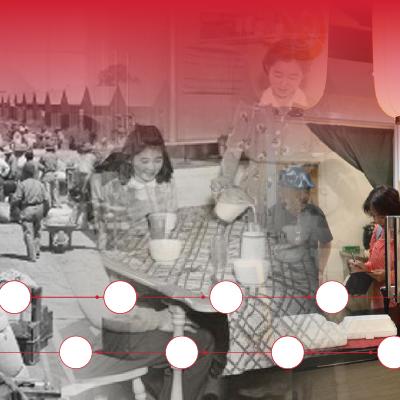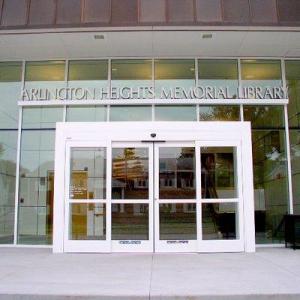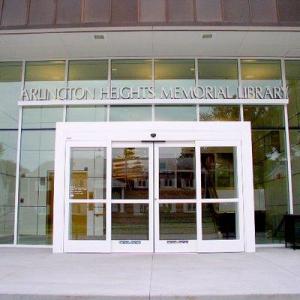
Want to dig deeper into the themes behind Clark and Division? Explore these resources:
Internment of Japanese Americans During World War II
- Japanese American Service Committee (JASC) Legacy Center: Organization whose mission is “to keep alive the cultural heritage of Japanese Americans in Chicago.” Their site includes archives and online exhibits.
- Densho: A website dedicated to the history of Japanese Americans during World War II.
- Discover Nikkei: Explore interviews, journals, photos, video and documents.
- The National WWII Museum | New Orleans: Japanese American Incarceration
- War Relocation Authority Photographs of Japanese-American Evacuation and Resettlement: A collection of War Relocation Authority (WRA) records that represent the official documentation of the agency. The WRA was in charge of the relocation centers and the resettlement program from 1942-1946.
- WTTW Chicago Internment Hearings, 1981: “'Every One of Those Folks Has a Story': The Chicago Hearings on Japanese Internment.” Article on the 1981 hearings investigating the constitutionality of the internment camps. Recordings from the hearings.
Japanese Americans arriving at an assembly center near Stockton, California, 1942. Image: National Archives and Records Administration, 210-G-C404.
Japanese Relocation to Chicago in the 1940s
- The Way Ahead: A propaganda film created by the War Relocation Authority, viewed by people when they left the internment camps to resettle in the Midwest.
- “What Happened to Chicago’s Japanese Neighborhood?”: Curious City article about Japan Town and how Japanese Americans resettled in Chicago.
- How Japanese Americans Built a ‘Useful American Life With all Possible Speed’ in 1940s Chicago: Essay describes the path from internment camps to settlement in Chicago through the experience of Kaye Kimura.
- Japanese Resettlement in Chicago: 400 Nikkei (Japanese people) lived in Chicago just before World War II, and that number increased to more than 20,000 by 1946-1947. This article describes the War Relocation Authority’s assimilationist vision and the reality of the vibrant community that settlers created.
- The Forgotten Story of Japanese American Zoot Suiters: Learn more about the young men described in Clark and Division as “zoot suiters.”
- Historical Materials: A list of resources from Nikkei Chicago to learn more about the history of Japanese Americans in Chicago.
"A big breakfast bright and early is the custom of the Katagiri and Kadoyama families who have relocated from Tule Lake to Arlington Heights, Illinois, where they work on a large chicken farm 15 miles northwest of Chicago. The site of this farm was once the home of the famous Arlington Heights golf course, but now the clubhouse has been converted into housing units, and in the other buildings are 10,000 chickens. The chicken farm produces broilers exclusively. They are sold to the large hotels and restaurants in the Chicago area. Shown from left to right are Mrs. Tei Katagiri at the toaster, David Katagiri, Phyllis Kadoyama, Mrs. Shizuko Kadoyama, and Carolyne Kadoyama. They are from Kent, Washington." January 6, 1944, Arlington Heights, Illinois. Image: War Relocation Authority photograph courtesy of UC Berkeley, Bancroft Library.
Chicago in the 1940s
- Chicago in the 1940s – A Film by the Chicago Board of Education: This film discusses Chicago industry and business as well as landmarks, recreation and neighborhoods.
- Chicago, 1947: A short educational film from the series “This Land of Ours” by Carl Dudley, which presents information about Chicago business, industry, railroads and recreation in the 1940s.
- Chicago, the Beautiful: One of the films in the Traveltalks series produced and narrated by James A. Fitzpatrick, “The Voice of the Globe.” The film discusses city landmarks, transportation and the lake in the 1940s.
Japanese Voices in Contemporary Culture
- Toyko Journal: Tokyo Journal is a magazine with a focus on all sectors of life and style, entertainment, events and Japanese culture.
- Toyko Weekender: Tokyo's longest-running English lifestyle magazine, packed with food, travel, city guides, news, interviews and more.
- Yo! Magazine: Yo! Magazine provides a platform to present and amplify own voices.
- Expand your understanding of Japanese American incarceration with the podcast Campu. This podcast tells the story of Japanese American internment like you’ve never heard it before. Follow along as brother-sister duo Noah and Hana Maruyama weave together the voices of survivors to spin narratives out of the seemingly mundane things that gave shape to the incarceration experience.
Places to Visit
- Anderson Japanese Gardens: Anderson Japanese Gardens is an authentic Japanese garden that inspires and energizes the soul. Located at 318 Spring Creek Rd. in Rockford, IL.
- Art Institute of Chicago: The Art Institute of Chicago has a wide-range collection of Japanese prints, as well as significant works of Buddhist art, painted folding screens, ceramics and kimonos.
- Floating World: One of the world’s leading galleries in fine Japanese art. Located at 1925 N. Halsted St. in Chicago, IL.
- Fabyan Villa Museum & Japanese Garden: The Japanese Garden is a tranquil oasis where history melds with nature and design. Located at 1925 S. Batavia Ave. in Geneva, IL.
- Manzanar War Relocation Center: Manzanar War Relocation Center was one of 10 camps where the U.S. government incarcerated Japanese immigrants ineligible for citizenship and Japanese American citizens during World War II. Located at Manzanar Reward Rd. in California.
- Mitsuwa Marketplace: A supermarket chain offering Japanese groceries, cosmetics, appliances and housewares. Located at 100 E. Algonquin Rd. in Arlington Heights, IL.
Toritetsu, a Japanese yakitori chain restaurant. Image: Kristen Pascual, Mitsuwa Marketplace.
Contemporary AAPI Anti-Racism Resources
- Asian Americans Advancing Justice | Chicago: An organization that builds power through collective advocacy and organizing to achieve racial equity.







